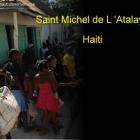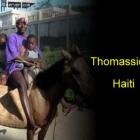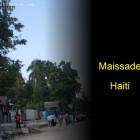ADVERTISEMENT
City
Pilate, Model Library
Pilate, a rural town, is a cityship in the Arrondissement of Plaisance, part of Nord Department. With a population of about 40,445 residents, it is comprised of eight communes: Ballon, Baudin, Ravine-Trompette, Joly, Dubourg, Riviere-Laporte, Margot, and Piment.
Agriculture is the main means of income, and farmers use subsistence-farming methods. Farmlands produce cocoa, yams, rice, and beans. Two crops grown that make up an essential component in the local diet are coffee and peanut butter. The town market, open all week, becomes more crowded on Saturdays, when people come from out of town.
Road infrastructure in Pilate is inferior. Dirt roads and cobblestone streets are hard to navigate by bike or car.
Ranquitte, a Tiny Community
Ranquitte is a rural village placed within the Saint-Rafaël Arrondissement, under the Nord Department. Located in the north-east sector of the island of Haiti, it has a population numbering about 24,000. Three districts comprise it: Bac-à-Soude, Cracaraille, and Bois-de-Lance.
Agricultural farming, the main economic force in the community, relies on coffee growing and small crops of lemons, limes, pineapples, and oranges. The under-production of coffee crop yields, lack of a paved road system, and on-going corruption activities have all ruined the coffee business there. When Ranquitte was first colonized, it had a notable reputation as a center of coffee production.
Richard Auguste Morse a Politician of Questionable Integrity
Richard Auguste Morse (birthdate 1957) is of Puerto Rican and American parentage, his father an academic and mother a noted Haitian music artist. He attended Princeton University, where he became a musician, singing music popular during the 80s. By 1985, conflicts in his personal and professional lives led him to re-settle in Port-au-Prince. He managed a decrepit hotel there, where he eventually formed RAM, a mizik rasin group. He also met his future wife, Lunise, who became a member of RAM.
Morse's political views are subject to un-predictable shifts in his allegiances to political parties and movements. Initially, he supported Jean-Bertrand Aristide, a pro-democracy politician. One of Morse's songs, "Fèy", became an underground expression of support for Aristide's Lavalas political party. But by the mid-90s, Morse, disappointed in Aristide's effectiveness as a leader, switched allegiances and became a vocal supporter of his cousin, Michel Martelly, who appointed him as his special advisor when Martelly came to power in 2011.
Saint-Rafael Gains Sovereignty from Dominican Republic
Saint-Rafael, a cityship within the Saint-Rafaël Arrondissement, is part of Nord Department. Established in 1761 by Viscount José Meléndez of San Rafaël de la Angostura, the town was originally named after his city, but later shortened to Saint-Raphaël. By 1783, about 1,000 residents populated Saint-Rafaël.
Until 1929, the Dominican Republic (DR) still laid claim to Saint-Rafaël. A treaty signed that year and revised in 1936 sought to reclaim Saint-Rafaël as the domain of its majority population. The revision indicated that residents, who comprised the dominant part of the population in a region, be granted sovereignty. As a result, the DR had to cede considerable land acreage.
Mineral Wealth of Trou-du-Nord will not Benefit Haitians
Trou-du-Nord is a cityship, capital of the Trou-du-Nord Arrondissement, and part of Nord Est Department. It lies in the northeast region of Haiti, with a population of 37,405 residents living in three sub-divisions, Garcin, Roucou and Roche-Plate.
The education system has a smattering of primary and secondary schools, whose students need sponsorships to pay tuition and school supplies. The primary organization offering sponsorships is the L'eglise Baptiste Trou-du-Nord Church, funding the education of 300 schoolchildren at its eponymous school.
The most pressing health challenge in Trou-du-Nord is the presence of malaria that is everywhere. The American Red Cross has a distribution program, whereby it hands out bed-nets to child-bearing women and young children. The program has been an enormous success, lowering the cases of the lethal illness significantly.
Capotille produces cassava, corn, and pistachios
Capotille, a northeastern cityship in Haiti, lays within the Ouanaminthe Arrondissement in the Nord Est Department. Capotille is one of two districts in the arrondissement, the other being Lamine.
Water is a plentiful resource in the town as it is situated near several waterways, the Colorado, Vizoneau, Mine, Nantes, and Bernard rivers. Not surprisingly, agricultural activities dominate Capotille's economy. Farmlands produce cassava, corn, and pistachios mainly, but there are plenty of mango, orange, and avocado trees dotting the landscape.
The town's infrastructure is adequate. Law enforcement has a presence there with a police station and courthouse, and city government is led by Mayor David Jean-Baptiste.
Dondon Cave History Intrigues
Dondon, situated within the Saint-Rafaël Arrondissement, is a third-level government division, part of Nord Department. Five rural villages make up Dondon: Bassin Caïman, Laguille, Brostage, Haut du Trou, and Matador. Estimates of the village's population range from 26,000 to 50,000.
Dondon is a farming village that produces coffee, cocoa, lemons, and sugar cane. The village infrastructure is weak, with no access to electric power and no paved roads. Very little auto traffic exists, the main modes of transportation horses and walking. No airport exists either, with the nearest located in Cap Haïtien.
The landscape of Dondon is striking, with mountain ranges, plains, and rivers bordering the village. From the ground floor looking up, an awe-inspiring sight greets the viewer. Colorful dwellings embedded in the mountainsides soar heavenwards, and stunning mountain-peak vistas succumb to plunging ravines everywhere in the village. And the villagers have heard rumors valuable mineral ore is hidden in the ridges burrowed into the mountainside.
Ferrier, originally named Maribeaux
Ferrier is a small cityship contained within the Fort Liberté Arrondissement, part of Nord Est Department. Located in north Haiti, it was established in 1932 and originally named Maribeaux. It was raised to the level of a cityship in 1946 and is comprised of a single commune, Maribaboux.
Farmers in Ferrier engage in sustainable farming. They produce oranges, tobacco, and limes, as well as livestock, to provide for themselves. The land in Ferrier is inadequately irrigated, but is a good place to grow rice, and has received funding from non-government organizations (NGO) to do so.
Infrastructure in Ferrier is underdeveloped. No road or electrical systems exist there, and the town is without an airport. If NGO workers want to travel out of the area, they must access airports miles away, the nearest being Les Cayes, and furthest, Port-au-Prince International Airport. The people in Ferrier also lack a hospital. To get medical attention, they must get to the nearest medical facility located 30 miles out of town in Milot.
The Town of Cabaret and its Challenges
Life has not been easy for people living in Cabaret, which is one of the two towns forming the Arrondissement of Arcahaie in the Ouest Department. About 63,450 people are residing in the town and for the past years, they have faced a lot of challenges, including deaths and calamities.
In 2010, Haiti has been hit by a devastating earthquake that killed tens of thousands of people. In relation with this, Cabaret has witnessed the deadly impact of the calamity as it served as mass graves for the victims. Outside Titanyen, which is one of the settlements in Cabaret, mass graves were dug for the victims of the earthquake. Some parts of the fields were chosen so as to have a place to lay the victims to rest.
Livelihood In the town of Carice, Haiti
Thousands of people live in Carice, a remote town located in the Vallieres arrondissement in Haiti. According to statistics, the town has about 12,000 residents. Carice is a rural area without as many sources of livelihood as in cities and industrialized towns. This is why people rely on agriculture for their main livelihood. Farmers in the town mostly harvest mangoes, bananas and coffee, which are considered the main and most popular products in the area.
Though agriculture is the main source of livelihood in the town, deforestation is still common. As a matter of fact, deforestation affected the soil quality in the town. Despite this, however, the production of crops remains and continues to support people's livelihood.
Our objective is to share with you news and information about Haiti and the people of Haiti. Traditions, habits and the way we were or grew are alive in this site. We highly recommend that you Subscribe to our Newsletter and also share with us some of the things that are memorable and made us unique people.

 Saint Michel de L 'Atalaye
Saint Michel de L 'Atalaye  Thomassique, Haiti
Thomassique, Haiti  Maissade, Haiti
Maissade, Haiti  Haiti tech Summit
Haiti tech Summit  Something to think about
Something to think about